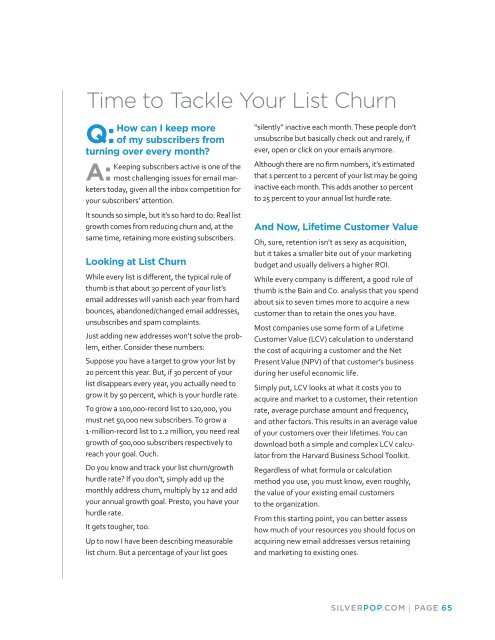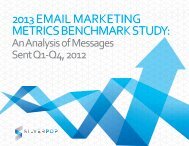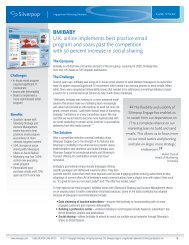eBook - Silverpop
eBook - Silverpop
eBook - Silverpop
You also want an ePaper? Increase the reach of your titles
YUMPU automatically turns print PDFs into web optimized ePapers that Google loves.
Time to Tackle Your List Churn<br />
How can I keep more<br />
Q: of my subscribers from<br />
turning over every month?<br />
Keeping subscribers active is one of the<br />
A: most challenging issues for email marketers<br />
today, given all the inbox competition for<br />
your subscribers’ attention.<br />
It sounds so simple, but it’s so hard to do: Real list<br />
growth comes from reducing churn and, at the<br />
same time, retaining more existing subscribers.<br />
Looking at List Churn<br />
While every list is different, the typical rule of<br />
thumb is that about 30 percent of your list’s<br />
email addresses will vanish each year from hard<br />
bounces, abandoned/changed email addresses,<br />
unsubscribes and spam complaints.<br />
Just adding new addresses won’t solve the problem,<br />
either. Consider these numbers:<br />
Suppose you have a target to grow your list by<br />
20 percent this year. But, if 30 percent of your<br />
list disappears every year, you actually need to<br />
grow it by 50 percent, which is your hurdle rate.<br />
To grow a 100,000-record list to 120,000, you<br />
must net 50,000 new subscribers. To grow a<br />
1-million-record list to 1.2 million, you need real<br />
growth of 500,000 subscribers respectively to<br />
reach your goal. Ouch.<br />
Do you know and track your list churn/growth<br />
hurdle rate? If you don’t, simply add up the<br />
monthly address churn, multiply by 12 and add<br />
your annual growth goal. Presto, you have your<br />
hurdle rate.<br />
It gets tougher, too.<br />
Up to now I have been describing measurable<br />
list churn. But a percentage of your list goes<br />
“silently” inactive each month. These people don’t<br />
unsubscribe but basically check out and rarely, if<br />
ever, open or click on your emails anymore.<br />
Although there are no firm numbers, it’s estimated<br />
that 1 percent to 2 percent of your list may be going<br />
inactive each month. This adds another 10 percent<br />
to 25 percent to your annual list hurdle rate.<br />
And Now, Lifetime Customer Value<br />
Oh, sure, retention isn’t as sexy as acquisition,<br />
but it takes a smaller bite out of your marketing<br />
budget and usually delivers a higher ROI.<br />
While every company is different, a good rule of<br />
thumb is the Bain and Co. analysis that you spend<br />
about six to seven times more to acquire a new<br />
customer than to retain the ones you have.<br />
Most companies use some form of a Lifetime<br />
Customer Value (LCV) calculation to understand<br />
the cost of acquiring a customer and the Net<br />
Present Value (NPV) of that customer’s business<br />
during her useful economic life.<br />
Simply put, LCV looks at what it costs you to<br />
acquire and market to a customer, their retention<br />
rate, average purchase amount and frequency,<br />
and other factors. This results in an average value<br />
of your customers over their lifetimes. You can<br />
download both a simple and complex LCV calculator<br />
from the Harvard Business School Toolkit.<br />
Regardless of what formula or calculation<br />
method you use, you must know, even roughly,<br />
the value of your existing email customers<br />
to the organization.<br />
From this starting point, you can better assess<br />
how much of your resources you should focus on<br />
acquiring new email addresses versus retaining<br />
and marketing to existing ones.<br />
SILVERPOP.COM | PAGE 65







